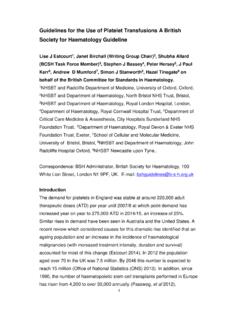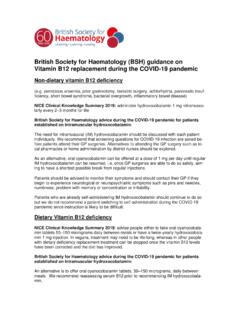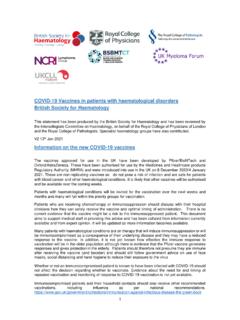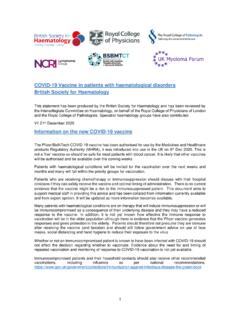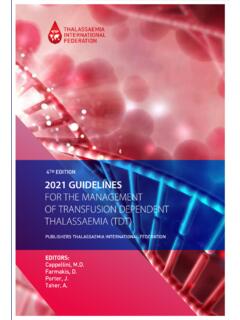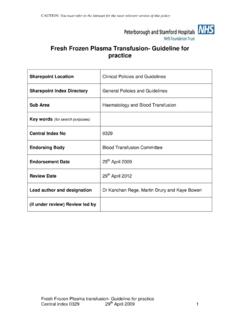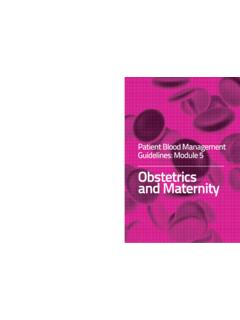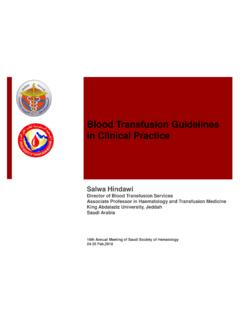Transcription of UK Guidelines on the management of iron deficiency in ...
1 UK Guidelines on the management of iron deficiency in pregnancyBritish Committee for Standards in for correspondence:BCSH SecretaryBritish Society for Haematology100 White Lion StreetLondon N1 9 PFe-mail group:S Pavord1, B Myers2, S Robinson3, S Allard4, J Strong5, C Oppenheimer6 Disclaimer: While the advice and information in these Guidelines is believed to be true and accurate at the time of going to press, neither the authors, the British Society for Haematology nor the publishers accept any legal responsibility for the content of these of BCSH approval: July 20111 University Hospitals of Leicester2 United Lincolnshire Hospitals Trust3 Guy s and St Thomas Hospital, London4 Bart s and the London NHS Trust & NHS Blood and Transplant5 Leicester Royal Infirmary6 Leicester Royal Infirmary1 | PageIntroductionIron deficiency is the most common deficiency state in the world, affecting more than 2 billion people globally. Although it is particularly prevalent in less-developed countries, it remains a significant problem in the developed world, even where other forms of malnutrition have already been almost eliminated.
2 Effective management is needed to prevent adverse maternal and pregnancy outcomes, including the need for red cell transfusion . The objective of this guideline is to provide healthcare professionals with clear and simple recommendations for the diagnosis, treatment and prevention of iron deficiency in pregnancy and the postpartum period. This is the first such guideline in the UK and may be applicable to other developed countries. Public health measures, such as helminth control and iron fortification of foods, which can be important to developing countries, are not considered guidance may not be appropriate to all patients and individual patient circumstances may dictate an alternative approach. MethodsThe guideline group was selected by the British Society for Haematology, Obstetric Haematology Group (BSH OHG) and British Committee for Standards in Haematology (BCSH), to be representative of UK-based medical experts.
3 MEDLINE and EMBASE were searched systematically for publications from 1966 until 2010 using the terms iron, anaemia, transfusion and pregnancy . Opinions were also sought from experienced obstetricians and practice development midwives. The writing group produced the draft guideline which was subsequently considered by the members of the BSH Obstetric Haematology Group and revised by consensus by members of the General Haematology Task Force of the BCSH. The guideline was then reviewed by a sounding board of approximately 50 UK haematologists, the BCSH and the BSH Committee and comments incorporated where appropriate. Criteria used to quote levels of recommendation and grades of evidence are as outlined in the Procedure for Guidelines Commissioned by the BCSH. Summary of key recommendations Anaemia is defined by Hb <110g/l in first trimester, <105g/l in second and third trimesters and <100g/l in postpartum period Full blood count should be assessed at booking and at 28 weeks All women should be given dietary information to maximise iron intake and absorption 2 | Page Routine iron supplementation for all women in pregnancy is not recommended in the UK Unselected screening with routine use of serum ferritin is generally not recommended although individual centres with a particularly high prevalence of at risk women may find this useful For anaemic women, a trial of oral iron should be considered as the first line diagnostic test.
4 Whereby an increment demonstrated at two weeks is a positive result Women with known haemoglobinopathy should have serum ferritin checked and offered oral supplements if their ferritin level is <30 ug/l Women with unknown haemoglobinopathy status with a normocytic or microcytic anaemia, should start a trial of oral iron (1B) and haemoglobinopathy screening should be commenced without delay in accordance with the NHS sickle cell and thalassaemia screening programme Non-anaemic women identified to be at increased risk of iron deficiency should have a serum ferritin checked early in pregnancy and be offered oral supplements if ferritin is <30 ug/l Systems must be in place for rapid review and follow up of blood results Women with established iron deficiency anaemia should be given 100-200mg elemental iron daily.
5 They should be advised on correct administration to optimise absorption Referral to secondary care should be considered if there are significant symptoms and/or severe anaemia (Hb<70 g/l) or late gestation (>34 weeks) or if there is failure to respond to a trial of oral iron. For nausea and epigastric discomfort, preparations with lower iron content should be tried. Slow release and enteric coated forms should be avoided Once Hb is in the normal range supplementation should continue for three months and at least until 6 weeks postpartum to replenish iron stores Non-anaemic iron deficient women should be offered 65mg elemental iron daily, with a repeat Hb and serum ferritin test after 8 weeks Anaemic women may require additional precautions for delivery, including delivery in a hospital setting, available intravenous access, blood group-and-save, active management of the third stage of labour, and plans for excess bleeding.
6 Suggested Hb cut-offs are <100g/l for delivery in hospital and <95g/l for delivery in an obstetrician-led unit 3 | Page Women with Hb <100g/l in the postpartum period should be given 100-200mg elemental iron for 3 months Parenteral iron should be considered from the 2nd trimester onwards and during the postpartum period for women with confirmed iron deficiency who fail to respond to or are intolerant of oral iron Blood transfusion should be reserved for those with risk of further bleeding, imminent cardiac compromise or symptoms requiring immediate attention. This should be backed up by local Guidelines and effective patient information 1. DEFINITION AND PREVALENCE OF IRON deficiency ANAEMIA IN DefinitionIron deficiency represents a spectrum ranging from iron depletion to iron deficiency anaemia. In iron depletion, the amount of stored iron (measured by serum ferritin concentration) is reduced but the amount of transport and functional iron may not be affected.
7 Those with iron depletion have no iron stores to mobilize if the body requires additional iron. In iron-deficient erythropoiesis, stored iron is depleted and transport iron (measured by transferrin saturation) is reduced further; the amount of iron absorbed is not sufficient to replace the amount lost or to provide the amount needed for growth and function. In this stage, the shortage of iron limits red blood cell production and results in increased erthryocyte protoporphyrin concentration. In iron- deficiency anaemia, the most severe form of iron deficiency , there is shortage of iron stores, transport and functional iron, resulting in reduced Hb in addition to low serum ferritin, low transferrin saturation and increased erythrocyte protoporphyrin is defined as Hb less than 2 standard deviations below the mean for a healthy matched population. However there is variation in what are considered normal values for pregnancy .
8 The World Health Organisation (WHO) defines anaemia in pregnancy as a haemoglobin concentration of <11g/dL WHO, 2001) whereas large studies in Caucasians have found a range between and in early third trimester, in women receiving iron supplements (Milman et al, 2007). In view of the relative plasma expansion being particularly marked in the second trimester, it would seem reasonable to take as the cut-off from 12 weeks, as suggested by the US Centers for disease control and prevention (CDC) (Dowdle, 1989; Ramsey et al, 2000). However there is a racial difference in normal Hb levels and the optimum Hb may be lower in those of African origin than in Europeans (Garn et al, 1981). The WHO defines postpartum anaemia as Hb < 4 | PageRecommendation: There is variation in definition of normal Hb levels in pregnancy . A level of 110g/l appears adequate in the first trimester and 105g/l in the second and third trimesters (1B).
9 Postpartum anaemia is defined as Hb <100g/l (2B). PrevalenceAnaemia affects billion people globally, corresponding to of the world population (McLean et al, 2009). Iron deficiency is the most common cause and even in the developed world an estimated 30- 40% of preschool children and pregnant women have iron depletion (WHO, 2008).2. CLINICAL EFFECTS OF IRON DEFICIENCYT issue enzyme malfunction occurs even in the early stages of iron deficient erythropoiesis and significant effects of iron deficiency anaemia have been described on maternal morbidity and mortality, fetal and infant development and pregnancy outcomes. Maternal morbidity and mortalityIron deficiency may contribute to maternal morbidity through effects on immune function with increased susceptibility or severity of infections (Eliz et al, 2005), poor work capacity and performance (Haas et al, 2001) and disturbances of postpartum cognition and emotions (Beard et al, 2005).
10 There is little information regarding the Hb thresholds below which mortality increases, although this may be as high as , which was associated with a doubling of the maternal death risk in Britain in a 1958 study (Brabin et al, 2001). However severe anaemia is likely to have multiple causes and the direct effect of the anaemia itself is unclear. Effects on the fetus and infantThe fetus is relatively protected from the effects of iron deficiency by upregulation of placental iron transport proteins (Gambling et al, 2001) but evidence suggests that maternal iron depletion increases the risk of iron deficiency in the first 3 months of life, by a variety of mechanisms (Puolakka et al, 1980, Colomer et al, 1990). Impaired psychomotor and/ or mental development are well described in infants with iron deficiency anaemia and may also negatively contribute to infant and social emotional behaviour (Perez et al, 2005) and have an association with adult onset diseases, although this is a controversial area (Beard et al, 2008; Insel et al, 2008).
